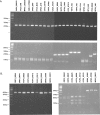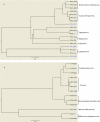GC content-based pan-pox universal PCR assays for poxvirus detection
- PMID: 19906902
- PMCID: PMC2812294
- DOI: 10.1128/JCM.01697-09
GC content-based pan-pox universal PCR assays for poxvirus detection
Abstract
Chordopoxviruses of the subfamily Chordopoxvirinae, family Poxviridae, infect vertebrates and consist of at least eight genera with broad host ranges. For most chordopoxviruses, the number of viral genes and their relative order are highly conserved in the central region. The GC content of chordopoxvirus genomes, however, evolved into two distinct types: those with genome GC content of more than 60% and those with a content of less than 40% GC. Two standard PCR assays were developed to identify chordopoxviruses based on whether the target virus has a low or high GC content. In design of the assays, the genus Avipoxvirus, which encodes major rearrangements of gene clusters, was excluded. These pan-pox assays amplify DNA from more than 150 different isolates and strains, including from primary clinical materials, from all seven targeted genera of chordopoxviruses and four unclassified new poxvirus species. The pan-pox assays represent an important advance for the screening and diagnosis of human and animal poxvirus infections, and the technology used is accessible to many laboratories worldwide.
Figures



Similar articles
-
Hypsugopoxvirus: A Novel Poxvirus Isolated from Hypsugo savii in Italy.Viruses. 2019 Jun 19;11(6):568. doi: 10.3390/v11060568. Viruses. 2019. PMID: 31248065 Free PMC article.
-
Salmon Gill Poxvirus, the Deepest Representative of the Chordopoxvirinae.J Virol. 2015 Sep;89(18):9348-67. doi: 10.1128/JVI.01174-15. Epub 2015 Jul 1. J Virol. 2015. PMID: 26136578 Free PMC article.
-
A novel poxvirus lethal to red squirrels (Sciurus vulgaris).J Gen Virol. 2003 Dec;84(Pt 12):3337-3341. doi: 10.1099/vir.0.19464-0. J Gen Virol. 2003. PMID: 14645914
-
[Progress on host range factors and their mechanisms of poxvirus].Bing Du Xue Bao. 2013 Nov;29(6):655-61. Bing Du Xue Bao. 2013. PMID: 24520773 Review. Chinese.
-
Orthopoxvirus diagnostics.Methods Mol Biol. 2004;269:119-34. doi: 10.1385/1-59259-789-0:119. Methods Mol Biol. 2004. PMID: 15114012 Review.
Cited by
-
Israeli Rousettus aegyptiacus Pox Virus (IsrRAPXV) Infection in Juvenile Egyptian Fruit Bat (Rousettus aegyptiacus): Clinical Findings and Molecular Detection.Viruses. 2021 Mar 4;13(3):407. doi: 10.3390/v13030407. Viruses. 2021. PMID: 33806696 Free PMC article.
-
Detection of North American orthopoxviruses by real time-PCR.Virol J. 2011 Jun 20;8:313. doi: 10.1186/1743-422X-8-313. Virol J. 2011. PMID: 21689420 Free PMC article.
-
Guidelines for the Laboratory Diagnosis of Monkeypox in Korea.Ann Lab Med. 2023 Mar 1;43(2):137-144. doi: 10.3343/alm.2023.43.2.137. Epub 2022 Oct 25. Ann Lab Med. 2023. PMID: 36281507 Free PMC article.
-
Molecular phylogenetic analysis of bovine papular stomatitis viruses detected in Saga, Japan.J Vet Med Sci. 2021 Sep 27;83(9):1489-1494. doi: 10.1292/jvms.20-0624. Epub 2021 Jul 31. J Vet Med Sci. 2021. PMID: 34334509 Free PMC article.
-
Incidental finding of a human-like tusavirus in a lamb with lip lesions and fatal pneumonia.J Gen Virol. 2024 Mar;105(3):001968. doi: 10.1099/jgv.0.001968. J Gen Virol. 2024. PMID: 38441565 Free PMC article.
References
-
- Centers for Disease Control and Prevention. 2008. Laboratory-acquired vaccinia exposures and infections—United States, 2005-2007. MMWR Morb. Mortal. Wkly. Rep. 57:401-404. - PubMed
-
- Damon, I. 2007. Poxviruses, p. 2947-2976. In D. M. Knipe, P. M. Howley, D. E. Griffin, R. A. Lamb, M. A. Martin, B. Roizman, and S. E. Straus (ed.), Fields virology, 5th ed. Lippincott Williams & Wilkins, Philadelphia, PA.
-
- Dhar, A. D., A. E. Werchniak, Y. Li, J. B. Brennick, C. S. Goldsmith, R. Kline, I. Damon, and S. N. Klaus. 2004. Tanapox infection in a college student. N. Engl. J. Med. 350:361-366. - PubMed
-
- Esposito, J. J., R. Condit, and J. Obijeski. 1981. The preparation of orthopoxvirus DNA. J. Virol. Methods 2:175-179. - PubMed
MeSH terms
Substances
Associated data
- Actions
- Actions
- Actions
- Actions
- Actions
- Actions
- Actions
- Actions
- Actions
- Actions
- Actions
- Actions
- Actions
- Actions
- Actions
- Actions
- Actions
- Actions
- Actions
LinkOut - more resources
Full Text Sources
Other Literature Sources
Miscellaneous

